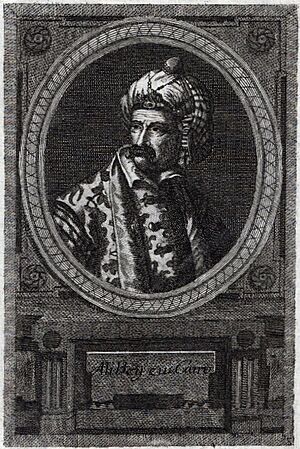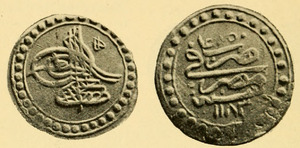Ali Bey al-Kabir facts for kids
Quick facts for kids
Ali Bey al-Kabir
|
|
|---|---|

Ali Bey al-Kabir (1728–1773)
|
|
| Shaykh al-Balad of Egypt (Chief of the Country) Sultan of Egypt | |
| In office 1760 – March 1766 |
|
| In office October 1767 – 1772 |
|
| Personal details | |
| Born | 1728 Principality of Abkhazia |
| Died | 8 May 1773 (aged 44–45) Cairo |
| Nicknames | Jinn Ali, Bulut Kapan |
Ali Bey al-Kabir (Arabic: علي بك الكبير, romanized: ʿAlī Bey al-Kābīr, Georgian: ალი ბეი ალ-ქაბირი; 1728 – 8 May 1773) was a powerful Mamluk leader in Egypt. He was known by nicknames like Jinn Ali ("Ali the Devil") and Bulut Kapan ("Cloud-Catcher"). Ali Bey became very important around 1768. He famously rebelled against the Ottoman rulers who controlled Egypt.
For a short time, he made Egypt independent from the Ottomans. However, his rule ended when his most trusted general, Abu al-Dhahab, turned against him. This led to Ali Bey's defeat and death.
Contents
Who Was Ali Bey al-Kabir?
Ali Bey was born in a place called Principality of Abkhazia. He was from a Georgian family. Some people say his father was a Greek Orthodox priest. Others believe he was a priest in the Georgian Orthodox Church.
When he was about 13, in 1741, he was kidnapped. He was then brought to Cairo, which was the capital of Ottoman Egypt. There, he was sold into slavery. In 1743, he was bought by Ibrahim Ketkhuda, who was also of Georgian origin.
Ali Bey's Early Career in Egypt
After the Ottoman Empire took over Egypt in 1518, they still used the Mamluks to help run the country. Mamluks were like trained slave soldiers and officials. The Ottoman Sultan, who was the main ruler, set up a complex system in Egypt. This was to make sure no one person had too much power.
The Ottoman governor, called a pasha, was the Sultan's main representative. But a Mamluk, usually the treasurer (called a defterdar), had a lot of power over money. Mamluks also held other important jobs, like leading the annual Muslim pilgrim trip to Mecca.
Mamluk Power Grows
By the early 1700s, the Mamluks became very strong in Egypt. They had more power than the Ottoman army units there. In 1711, a civil war broke out between two main Mamluk groups, the Faqariya and the Qasimiya. The Qasimiya won, but then they split up.
This allowed a new Mamluk group, the Qazdughliya, to rise to power. This civil war showed that the Mamluk leaders (called beys) were now the main military power in Egypt. They controlled Egyptian politics for the rest of the 18th century. The Sultan even created a new title for the most important Mamluk bey: shaykh al-balad (chief of the country).
Ali Bey's Rise to Power
Ali Bey's master, Ibrahim Ketkhuda, was a leader of the Qazdughli group. He helped them win against rivals. By 1748, Ibrahim Ketkhuda and his partner, Ridwan Ketkhuda, brought stability to Egypt. Ali Bey moved up the ranks in Ibrahim Ketkhuda's group.
In 1749, Ali became a kashif. This was a rank below a bey. Kashifs were powerful administrators in rural areas. They managed groups of villages.
In 1753 or 1754, Ali became the amir al-hajj. This was a very important job. He led the yearly pilgrim caravan to Mecca. During this trip, he bravely attacked Bedouin (nomadic) tribes in the desert.
He earned his Turkish nickname, Balut Kapan, which means 'he who catches clouds'. This was because the Bedouin were as hard to catch as clouds. His Arabic nickname, Jinn Ali ('Ali the demon'), also showed how fierce he was. After returning from the Hajj, Ali became a bey.
Becoming Shaykh al-Balad
Ali Bey faced some challenges. He was exiled from Cairo for a time. But he was later called back by other powerful Mamluks. In 1760, Ali Bey became the new shaykh al-balad. This meant he was the chief of the country.
Ali Bey as Shaykh al-Balad
First Term as Leader
Even though Ali Bey was officially the shaykh al-balad, another influential Mamluk, Abd al-Rahman, held the real power. Ali Bey wanted complete control. He decided to get rid of his rivals. He also wanted to promote his own Mamluks to important positions.
He started his push for power in 1763. He exiled several army officers and arrested some priests for money. In 1765, he exiled Abd al-Rahman. By 1766, Ali Bey had 3,000 Mamluks and made eight of them beys.
Exile and Return
Ali Bey's actions worried the Ottoman government. They sent a new governor, Hamza Pasha, with secret orders to stop Ali Bey. The governor brought back Ali Bey's main rival, Husayn Bey Kishkish. Ali Bey tried to poison Husayn Bey, but the plot was discovered.
Ali Bey was forced to step down as shaykh al-balad. He took refuge in Gaza, near Egypt's border. In Gaza, Ali Bey connected with Zahir al-Umar, a strong leader in northern Palestine. He gained Zahir's support.
The new rulers in Egypt were very harsh. So, Hamza Pasha helped Ali Bey return to Egypt. On September 6, 1766, Ali Bey and his top Mamluks came back to Cairo. They demanded to be part of the Mamluk ruling council again.
At first, they were not allowed back fully. Ali Bey was sent to a village, and his followers went to Upper Egypt. But Ali Bey kept communicating with his supporters in Cairo. This led to more conflict.
The Ottoman government then sent a new governor, Rakım Mehmed Pasha. His job was to control the Mamluks and support Ali Bey. Ali Bey formed an alliance with another Mamluk leader, Salih Bey. They rebelled against the current rulers. They blocked traffic on the Nile River, stopping food and tax payments to Cairo.
In autumn 1767, Ali Bey and Salih Bey marched on Cairo. The governor, who wanted to remove the current rulers, ordered the Ottoman army units to stand down. Without a fight, Ali Bey and Salih Bey entered Cairo in October. Rakım Mehmed Pasha recognized Ali Bey as shaykh al-balad again.
Taking Full Control
Ali Bey quickly began to remove his rivals. In November 1767, he killed two high-ranking Mamluks. He also expelled four other beys from Egypt. In March 1768, he exiled about thirty officers, including many from his ally Salih Bey's group.
In May, Husayn Bey and Khalil Bey tried to fight Ali Bey from Gaza. Ali Bey got official permission from the governor to declare them rebels. This allowed him to use government money against them. His generals, Muhammad Bey Abu al-Dhahab and Salih Bey, defeated the rebels. Husayn Bey was killed.
Ali Bey continued to weaken or remove rivals among the Mamluks and army units. By September, the French consul reported that the main army unit, the Janissaries, was weaker than ever. That month, Ali Bey had Salih Bey killed. He then broke up Salih Bey's group, exiling his Mamluks.
With each move, Ali Bey gained more control over Egypt's military and government. He replaced all the officers he removed with his own Mamluks. He also bought many new Mamluks and hired soldiers to strengthen his forces. He even took over the executive powers of the governor. This made the Ottoman governor almost powerless.
In 1769, Ali Bey stopped sending the yearly tribute money to the Ottoman Sultan. He also put his name on local coins, which was a right only the Sultan had. This was like declaring Egypt's independence from Ottoman rule. In 1770, he took control of the Hijaz region. A year later, he briefly took over Syria. This was like bringing back the old Mamluk state that had disappeared in 1517.
However, after a big victory in Syria in June 1771, his general, Abu al-Dhahab, refused to continue fighting. An Ottoman agent had made Abu al-Dhahab distrust Ali Bey. Abu al-Dhahab quickly returned to Egypt. Because of this, Ali Bey lost power in 1772. The next year, he was killed in Cairo.
It's worth noting that historians have different ideas about when Ali Bey's power truly ended. Some say 1773, while others say 1769.
Ali Bey's Economic Ideas
Historians Cleveland and Bunton say that during his time in power, Ali Bey successfully increased Egypt's trade with Britain and France. They also mention that he hired European advisors for his military and bought European weapons.
However, another historian, Bidwell, says that Ali Bey did not use Egyptians or foreign experts for technical advice. He also states that Ali Bey did not try to build a modern army.
See also
Literature
- Sauveur Lusignan: A history of the Revolution of Ali Bey against the Ottoman Porte. London 1783



